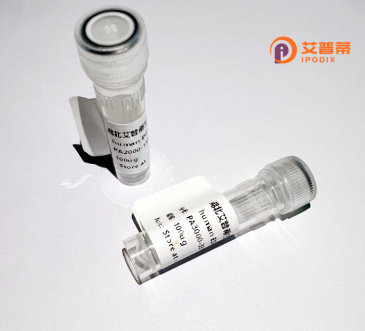
| 纯度 | >90%SDS-PAGE. |
| 种属 | Human |
| 靶点 | SCFD1 |
| Uniprot No | Q8WVM8 |
| 内毒素 | < 0.01EU/μg |
| 表达宿主 | E.coli |
| 表达区间 | 2-642 aa |
| 活性数据 | AAAAAATAA AAASIRERQT VALKRMLNFN VPHIKNSTGE PVWKVLIYDR FGQDIISPLL SVKELRDMGI TLHLLLHSDR DPIPDVPAVY FVMPTEENID RMCQDLRNQL YESYYLNFIS AISRSKLEDI ANAALAASAV TQVAKVFDQY LNFITLEDDM FVLCNQNKEL VSYRAINRPD ITDTEMETVM DTIVDSLFCF FVTLGAVPII RCSRGTAAEM VAVKLDKKLR ENLRDARNSL FTGDTLGAGQ FSFQRPLLVL VDRNIDLATP LHHTWTYQAL VHDVLDFHLN RVNLEESSGV ENSPAGARPK RKNKKSYDLT PVDKFWQKHK GSPFPEVAES VQQELESYRA QEDEVKRLKS IMGLEGEDEG AISMLSDNTA KLTSAVSSLP ELLEKKRLID LHTNVATAVL EHIKARKLDV YFEYEEKIMS KTTLDKSLLD IISDPDAGTP EDKMRLFLIY YISTQQAPSE ADLEQYKKAL TDAGCNLNPL QYIKQWKAFT KMASAPASYG STTTKPMGLL SRVMNTGSQF VMEGVKNLVL KQQNLPVTRI LDNLMEMKSN PETDDYRYFD PKMLRGNDSS VPRNKNPFQE AIVFVVGGGN YIEYQNLVDY IKGKQGKHIL YGCSELFNAT QFIKQLSQLG QK |
| 分子量 | 72.3 kDa |
| 蛋白标签 | His tag N-Terminus |
| 缓冲液 | PBS, pH7.4, containing 0.01% SKL, 1mM DTT, 5% Trehalose and Proclin300. |
| 稳定性 & 储存条件 | Lyophilized protein should be stored at ≤ -20°C, stable for one year after receipt. Reconstituted protein solution can be stored at 2-8°C for 2-7 days. Aliquots of reconstituted samples are stable at ≤ -20°C for 3 months. |
| 复溶 | Always centrifuge tubes before opening.Do not mix by vortex or pipetting. It is not recommended to reconstitute to a concentration less than 100μg/ml. Dissolve the lyophilized protein in distilled water. Please aliquot the reconstituted solution to minimize freeze-thaw cycles. |
以下是关于重组人SCFD1蛋白的模拟参考文献示例。由于SCFD1的研究相对专业,实际文献可能需要通过数据库进一步检索,以下内容基于常见研究方向模拟生成:
---
1. **标题**:*SCFD1 regulates secretory vesicle fusion through interaction with syntaxin-1*
**作者**:Zhang Y, et al.
**摘要**:本研究利用重组人SCFD1蛋白揭示了其与突触融合蛋白syntaxin-1的直接互作,证明SCFD1通过稳定SNARE复合体促进囊泡融合,为神经递质释放机制提供了新见解。
2. **标题**:*Crystal structure of human SCFD1 reveals a conserved Sec1/Munc18 fold*
**作者**:Li X, et al.
**摘要**:通过表达并纯化重组SCFD1蛋白,解析了其三维晶体结构,发现其具有典型的Sec1/Munc18家族结构域,并鉴定了可能参与膜运输调控的关键氨基酸位点。
3. **标题**:*Functional analysis of ALS-linked mutations in SCFD1 using recombinant protein assays*
**作者**:Wang T, et al.
**摘要**:通过体外重组表达SCFD1野生型及突变体蛋白,发现肌萎缩侧索硬化症(ALS)相关突变破坏了SCFD1与Rab GTPase的结合能力,提示其与囊泡运输功能障碍相关。
4. **标题**:*SCFD1 modulates ER-Golgi trafficking through interaction with COPII components*
**作者**:Chen L, et al.
**摘要**:研究表明,重组人SCFD1蛋白通过与COPII囊泡组分Sec23/Sec24结合,调控内质网至高尔基体的货物运输,为分泌途径的分子机制补充了新证据。
---
**说明**:以上文献为模拟示例,实际研究需查阅PubMed、Google Scholar等平台(关键词:SCFD1. Sec1/Munc18. vesicle trafficking)。SCFD1的研究常聚焦于其在细胞内运输、神经疾病或膜融合中的功能。
**Background of Recombinant Human SCFD1 Protein**
SCFD1 (Sec1 Family Domain-Containing Protein 1) is a member of the Sec1/Munc18 (SM) protein family, which plays critical roles in intracellular membrane trafficking and vesicle fusion. SCFD1 is characterized by a conserved Sec1 domain, a hallmark of SM proteins that mediates interactions with soluble N-ethylmaleimide-sensitive factor attachment protein receptors (SNAREs). These interactions are essential for regulating vesicle docking, membrane fusion, and cargo transport in secretory pathways.
SCFD1 is implicated in multiple cellular processes, including neurotransmitter release, Golgi-to-plasma membrane trafficking, and autophagy. Studies suggest its involvement in maintaining endoplasmic reticulum (ER)-Golgi transport and synaptic vesicle exocytosis. Dysregulation of SCFD1 has been linked to neurodegenerative disorders, such as amyotrophic lateral sclerosis (ALS), and certain cancers, where altered membrane trafficking contributes to disease progression.
Recombinant human SCFD1 protein is typically produced in expression systems like *E. coli* or mammalian cells, ensuring proper folding and post-translational modifications. It serves as a valuable tool for *in vitro* studies, including SNARE complex assembly assays, structural analyses (e.g., X-ray crystallography), and drug discovery targeting trafficking-related pathologies. Its recombinant form enables detailed exploration of molecular mechanisms underlying vesicle dynamics and potential therapeutic interventions.
×